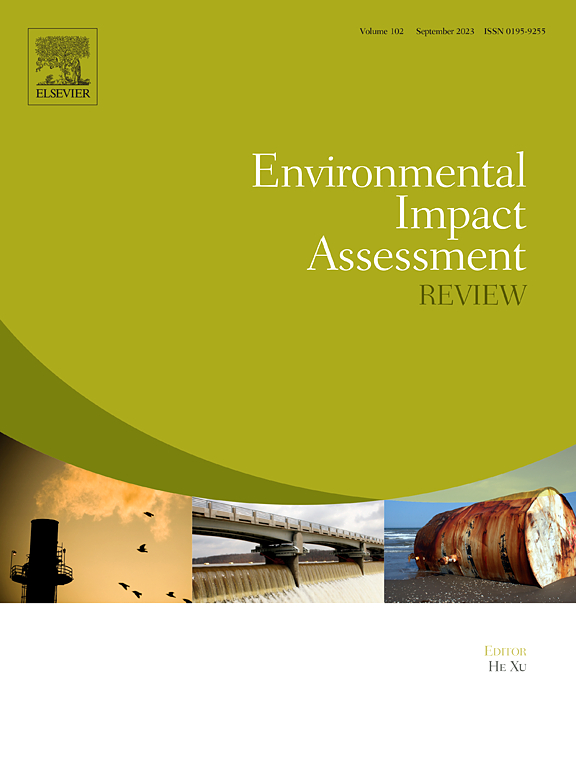Life-cycle environmental burdens of cultivated seaweed as blue food: The case study of Wakame and Kelp in Dalian, China
IF 9.8
1区 社会学
Q1 ENVIRONMENTAL STUDIES
引用次数: 0
Abstract
Cultivated seaweed, known as typical blue food, benefits environmental sustainability like climate change mitigation when replacing land-based food with carbon-intensive fertilizer input. However, seaweed cultivation still generates environmental burdens that remain unclear, especially in China, where approximately 60 % of global seaweed is cultured. Here, we developed life cycle assessment (LCA) models to quantitatively compare the environmental performance of two seaweed species of wakame (Undaria pinnatifida) and kelp (Saccharina japonica) cultivated by floating rafts. We also developed scenarios to examine the environmental performance by controlling the seedling density and cultivation line inputs. Results show that the environmental loads of wakame are 10–40 % higher than those of kelp, with carbon footprints of 44–59 kgCO2e and 37–58 kgCO2e per ton wet weight, respectively. Seaweed cultivation at sea produces the most environmental burdens. The polyethylene cultivation lines are the crucial input influencing environmental performance. Extending the service time of cultivation lines by 10 % reduces the environmental load by ∼5 % on average. Lower seedling density with fewer cultivation line inputs slightly decreases the environmental burden but with less seaweed yield. Nitrogen and phosphorus removed by seaweed harvest are two orders of magnitude lower than fertilizers applied in land cropping systems of coastal provinces but are four orders higher than the life-cycle emissions of seaweed cultivation. We reviewed the carbon footprint of previous investigations on seaweed farming to compare with ours. Our study adds new knowledge to quantitatively understand the environmental burdens of cultured seaweed (especially for wakame Undaria pinnatifida) as a blue food alternative to land-based foods.
作为蓝色食品的栽培海藻的生命周期环境负担:中国大连裙带菜和海带案例研究
养殖的海藻被称为典型的蓝色食品,它可以替代陆地上使用碳密集型肥料的食品,有利于环境的可持续发展,如减缓气候变化。然而,海藻养殖所产生的环境负担仍不明确,尤其是在中国,全球约 60% 的海藻都是在中国养殖的。在此,我们开发了生命周期评估(LCA)模型,定量比较了浮筏养殖裙带菜和海带这两种海藻的环境绩效。我们还制定了一些方案,通过控制育苗密度和栽培线投入来检验环境绩效。结果表明,裙带菜的环境负荷比海带高 10-40%,每吨湿重的碳足迹分别为 44-59 kgCO2e 和 37-58 kgCO2e。海上养殖海藻对环境造成的负担最大。聚乙烯栽培线是影响环境绩效的关键投入。将栽培线的使用时间延长 10%,可将环境负荷平均降低 5%。减少栽培线投入,降低育苗密度,可略微减轻环境负担,但海藻产量会减少。海藻收获所去除的氮和磷比沿海省份陆地种植系统施用的肥料低两个数量级,但比海藻养殖生命周期的排放量高四个数量级。我们回顾了以往关于海藻养殖的碳足迹调查,并与我们的研究进行了比较。我们的研究为定量了解养殖海藻(尤其是裙带菜)作为陆基食品的蓝色替代品对环境造成的负担增添了新的知识。
本文章由计算机程序翻译,如有差异,请以英文原文为准。
求助全文
约1分钟内获得全文
求助全文
来源期刊

Environmental Impact Assessment Review
ENVIRONMENTAL STUDIES-
CiteScore
12.60
自引率
10.10%
发文量
200
审稿时长
33 days
期刊介绍:
Environmental Impact Assessment Review is an interdisciplinary journal that serves a global audience of practitioners, policymakers, and academics involved in assessing the environmental impact of policies, projects, processes, and products. The journal focuses on innovative theory and practice in environmental impact assessment (EIA). Papers are expected to present innovative ideas, be topical, and coherent. The journal emphasizes concepts, methods, techniques, approaches, and systems related to EIA theory and practice.
 求助内容:
求助内容: 应助结果提醒方式:
应助结果提醒方式:


